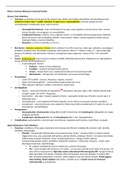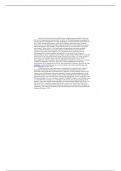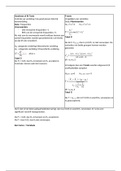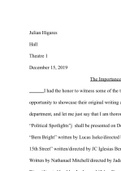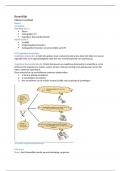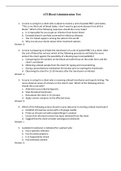Minor/ Common Illnesses in General Practice
Urinary Tract Infections
Overview: an infection of any part of the urinary tract, which may include colonisation and ascending spread.
Infection of lower tract = cystitis. Infection of upper tract = pyelonephritis. Clinically categorised into
uncomplicated/ complicated, acute, and recurrent.
o Uncomplicated features: males and females of any age, usual organism, normal urinary tract, normal
urinary function, non-pregnant, no-comorbidities
o Complicated features: children, men, pregnant women, co-morbidities (immunosuppressed, diabetes),
abnormal urinary tract (indwelling catheter, vesicoureteric reflux), virulent organisms (staph aureus),
treatment failure, recurrent infection.
o Recurrent: ≥2 UTIs in 6 months, or ≥3 in 1y.
Risk factors: diabetes, pregnancy, female (short urethra), Hx of UTI, recent sex, older age, catheters, neurological
problems (residual urine, incomplete emptying), vesicoureteric reflux (1°= defect in valve, 2° = abnormally high
pressure in bladder), and obstruction (tumours, enlarged prostate, pregnancy, stones at PUJ, VUJ, and pelvic
inlet).
Causes: Escherichia coli (most common), proteus mirabilis, Klebsiella pneumoniae, Staphylococcus saprophyticus
(young women and hospitalised pt)
o E-coli pathogenic factors:
Fimbriae – attach to host epithelium
K antigen – produces polysaccharide capsule
Urease – breaks down urea creating favourable env for bacterial growth
Haemolysins – damage host cell membranes and cause renal damage.
Presentation:
o Lower UTI (cystitis) – dysuria, frequency, urgency, nocturia
o Upper UTI (pyelonephritis) – costovertebral angle tenderness, fever
o Other features: delirium in elderly, haematuria, cloudy urine
Investigations:
o History – onset and evolution of symptoms ( haematuria, loin pain, rigors, N&V, altered mental state –
consider sepsis). FH of UTI. ?Pregnancy.
o Examination – vital signs (?sepsis), palpate for flank / suprapubic tenderness (Murphy’s punch sign), or
abdominal mass.
o Uncomplicated – urine dipstick (UTI likely if dipstick +ve for nitrite or leucocyte esterase and RBCs)
o Complicated – send mid-stream urine sample for MC&S. Renal USS and abdo/pelvic CT useful to rule out
renal abscess, and urolithiasis.
Management:
o Uncomplicated: nitrofurantoin 100mg BDS 3d (GFR ≥45ml/min), OR trimethoprim 200mg BDS 3d, simple
analgesia and fluids
o Complicated: ciprofloxacin BDS 7d, OR trimethoprim BDS 7-14d. ?Hospitalisation.
Complications: pyelonephritis, renal and peri-renal abscess, impaired renal function, renal failure, urosepsis
Upper Respiratory Tract Infections
Overview: conditions of the upper respiratory tract (sinuses and throat), including the common cold, sinusitis,
tonsillitis, and laryngitis
o Sinusitis = symptomatic inflammation of paranasal sinuses. Acute – resolves within 12 weeks (usually
triggered by virus, also associated with asthma, allergic rhinitis, smoking). Chronic >12 weeks (more likely
inflammatory instead of infective cause. Predisposing factors = allergic rhinitis, asthma,
immunocompromised, aspirin sensitivity). Diagnostic symptoms = facial pain/ pressure, smell, nasal
discharge (nasal drip), nasal blockage.
Ix = palpate maxillofacial area for tenderness, anterior rhinoscopy
Mx = acute sinusitis self-resolves in 2-3 weeks – as most are viral Abx won’t help. If Sx persist >10
days with no improvement, high-dose nasal corticosteroid 200 micrograms BD. Can give back up
Abx prescription if Sx persist. Consider referral if frequent recurrent episodes, Tx failure after
Abx, immunocompromised. If chronic, inform patient it can last several months. Avoid triggers,
stop smoking. Nasal irrigation with saline. Consider up to 3-month course of intranasal
corticosteroids e.g. fluticasone.
, Presentation: blocked, runny nose, sore throat, headaches, muscle aches, coughs, sneezing, fever, pressure in
ears and face, loss of taste and smell. Green or yellow mucus, toothache.
Management:
o Supportive: rest, hydration, gargling saltwater, intranasal decongestant sprays (long-term use can
rebound congestion), steam inhalation, analgesia, avoid allergic triggers, not smoking, saline nasal
irrigation to ease congestion.
o See GP if symptoms are severe, painkillers not helping, symptoms not improving after 1w, recurrent
infection.
o GP can prescribe steroid nasal sprays, antihistamines, abx (if due to bacterial infection). May warrant
referral to ENT.
Tonsillitis
Overview: acute infection of the palatine tonsils. Usually viral
(rhinovirus, coronavirus, adenovirus), but 10-30% are bacterial by
group A beta haemolytic streptococci (Strep. pyogenes).
Risk factors: age between 5-15, contact with infected people in
enclosed spaces (schools)
Pathophysiology: local inflammatory pathways result in
oropharyngeal swelling, oedema, erythema and pain. Swelling can
progress to the soft palate and uvula, or to the supraglottic region.
Presentation: dysphagia, fever >38°C, tonsillar exudates (purulent –
see Centor criteria), sudden onset sore throat, headaches, abdo
pain, halitosis, red swollen tonsils, enlarged anterior cervical lymph
nodes.
Differentials: Infectious mononucleosis (glandular fever), Coxsackie
virus, Peritonsillar abscess, Epiglottitis, malignancy.
Investigations: temperature, lymph node exam, otoscopy (to
rule out concomitant OM) , use torch to view tonsils/ back of
throat.
o Throat culture, rapid streptococcal antigen test,
serological testing, HIV test
o WBC count – useful in ?EBV (raised, with
lymphocytosis, and atypical lymphocytes),
immunocompromised, sepsis
o Centor criteria and feverPAIN score are used to
determine management in cases of ?strep throat.
Management:
o Analgesia, hydration, salt-water
gargling
o Abx for bacterial strep throat:
1st line =
Phenoxymethylpenicillin 10d,
Amoxicillin 10d, 2nd line =
Azithromycin 5d.
o Corticosteroids (dexamethasone
sodium phosphate,
prednisolone) can be used for
severe symptoms like
oropharyngeal swelling
o Recurrent tonsillitis –
tonsillectomy
Complications: scarlet fever, acute
sinusitis, AOM, peri-tonsillar abscess, PANDAS, streptococcal toxic shock syndrome.
Chest Infections
Overview: conditions of the airways and lungs, including bronchitis (LRTI that causes inflammation in bronchial
airways), bronchiolitis, pneumonia and COVID-19. A LRTI – acute illness usually with cough as the main symptom,
and with at least one other LRT symptom (e.g. fever, sputum, breathlessness, wheeze, chest pain/discomfort) and
no other explanation. Symptoms are generally self-limiting and clear on their own in 7-10d, can last up to 3wks
, Causes (bronchitis mainly viral, CAP usually bacterial): Streptococcus pneumoniae, Coronavirus, RSV, influenza
A+B, Adenovirus.
Pathophysiology: acute inflammation of the bronchial wall, microbial overgrowith in the lung parenchyma leading
to oedema, and exudates.
Presentation: any/all of chesty cough, green/yellow mucus, chest pain and discomfort, high temp >38°C,
headache, aching muscles, tiredness
Investigations: clinical diagnosis, O2 sats, obs, PFT, CXR if suspected CAP, CRP (rule out pneumonia). Use CRB-65
score to see if adult with CAP needs hospital admission (urgent admission if 3+).
Management: supportive measures (rest, hydration, head up whilst sleeping to make breathing easier, lemon and
honey, analgesia to reduce fever and headaches)
o 1° care – advise that viruses clear up by themselves, and Abx won’t help.
o Prescribe Abx if: patient is systemically unwell, patient at risk of complications (i.e. comorbid), young
children who were born prematurely, older patient who have been hospitalised in the past year/ are on
corticosteroids/ are diabetic/ of have CCF. Can also give if symptoms are unresolved after 10 days.
Abx – amoxicillin 500mg TDS for 5 days, or doxycycline (200mg on first day, then 100mg OD for
4 days).
o Advise pt to stop smoking.
o Advise to seek medical help if symptoms rapidly worsen, do not improve after 3-4 weeks, or they become
systemically unwell.
Complications – pneumonia is a complication of acute bronchitis. CAP pleural effusion, empyema, lung abscess,
ARDS
Back pain
Overview: very common affecting 8/10 people at some
point in their life. Usually improves in weeks to month.
Usually not caused by anything serious. Acute <6weeks,
Sub-acute 6-12 weeks, chronic >12weeks.
Lower back pain red flags = age <20 or >50, history of
previous malignancy, night pain, history of trauma,
systemically unwell e.g. weight loss
Risk factors: aging, FH, occupational, sedentary lifestyle,
excess weight, poor posture, pregnancy.
Pathophysiology:
o Mechanical: pain elicited with motion, decreases
with rest. Most common aetiology.
Spinal stenosis – usually gradual onset. Unilateral or bilateral leg pain, numbness and weakness.
Mimics peripheral arterial disease, patient may find it easier to walk uphill rather than downhil.
Resolves when sitting down, also relieved by leaning forwards and crouching down. Pain may be
described as ‘aching’ or ‘crawling’. Examination often normal. MRI to confirm.
Slipped disc – usually clear dermatomal leg pain and neurological defects. Leg pain worse
back pain. Pain often worse when sitting.
Vertebral compression fractures – force causes vertebral body to collapse. Trauma is a cause,
VCF is often associated with osteoporosis.
Spondylosis
Spondylolisthesis
o Systemic: warrant further work up, possible urgent referral. Includes infection (discitis, osteomyelitis,
epidural abscess), malignancy, inflammatory spondyloarthropathy (AS, Psoriatic arthritis), CT disorders,
osteoporosis. Likely to be other Sx.
Ankylosing spondylitis – typically a young man presenting with LBP and stiffness. Stiffness is
usually worse in the morning and improves with activity.
o Referred: AAA, acute pancreatitis, pyelonephritis, renal colic, PUD.
Presentation: muscle aches, shooting or stabbing pain, pain that radiates down leg, worsens with bending, lifting,
walking, improves with reclining.
o Thoracic pain is a red flag for back pain, as this is the most common region for metastases.
Differentials
o Strain/sprain, spinal stenosis, compression fracture, degenerative disc disease, sacroiliitis, spondylosis,
spondylolisthesis, pancreatitis, pyelonephritis, renal colic, peptic ulcer disease.
o herniated nucleus pulposus, CES, vertebral discitis (osteomyelitis), malignancy, AAA, spinal epidural
abscess
Urinary Tract Infections
Overview: an infection of any part of the urinary tract, which may include colonisation and ascending spread.
Infection of lower tract = cystitis. Infection of upper tract = pyelonephritis. Clinically categorised into
uncomplicated/ complicated, acute, and recurrent.
o Uncomplicated features: males and females of any age, usual organism, normal urinary tract, normal
urinary function, non-pregnant, no-comorbidities
o Complicated features: children, men, pregnant women, co-morbidities (immunosuppressed, diabetes),
abnormal urinary tract (indwelling catheter, vesicoureteric reflux), virulent organisms (staph aureus),
treatment failure, recurrent infection.
o Recurrent: ≥2 UTIs in 6 months, or ≥3 in 1y.
Risk factors: diabetes, pregnancy, female (short urethra), Hx of UTI, recent sex, older age, catheters, neurological
problems (residual urine, incomplete emptying), vesicoureteric reflux (1°= defect in valve, 2° = abnormally high
pressure in bladder), and obstruction (tumours, enlarged prostate, pregnancy, stones at PUJ, VUJ, and pelvic
inlet).
Causes: Escherichia coli (most common), proteus mirabilis, Klebsiella pneumoniae, Staphylococcus saprophyticus
(young women and hospitalised pt)
o E-coli pathogenic factors:
Fimbriae – attach to host epithelium
K antigen – produces polysaccharide capsule
Urease – breaks down urea creating favourable env for bacterial growth
Haemolysins – damage host cell membranes and cause renal damage.
Presentation:
o Lower UTI (cystitis) – dysuria, frequency, urgency, nocturia
o Upper UTI (pyelonephritis) – costovertebral angle tenderness, fever
o Other features: delirium in elderly, haematuria, cloudy urine
Investigations:
o History – onset and evolution of symptoms ( haematuria, loin pain, rigors, N&V, altered mental state –
consider sepsis). FH of UTI. ?Pregnancy.
o Examination – vital signs (?sepsis), palpate for flank / suprapubic tenderness (Murphy’s punch sign), or
abdominal mass.
o Uncomplicated – urine dipstick (UTI likely if dipstick +ve for nitrite or leucocyte esterase and RBCs)
o Complicated – send mid-stream urine sample for MC&S. Renal USS and abdo/pelvic CT useful to rule out
renal abscess, and urolithiasis.
Management:
o Uncomplicated: nitrofurantoin 100mg BDS 3d (GFR ≥45ml/min), OR trimethoprim 200mg BDS 3d, simple
analgesia and fluids
o Complicated: ciprofloxacin BDS 7d, OR trimethoprim BDS 7-14d. ?Hospitalisation.
Complications: pyelonephritis, renal and peri-renal abscess, impaired renal function, renal failure, urosepsis
Upper Respiratory Tract Infections
Overview: conditions of the upper respiratory tract (sinuses and throat), including the common cold, sinusitis,
tonsillitis, and laryngitis
o Sinusitis = symptomatic inflammation of paranasal sinuses. Acute – resolves within 12 weeks (usually
triggered by virus, also associated with asthma, allergic rhinitis, smoking). Chronic >12 weeks (more likely
inflammatory instead of infective cause. Predisposing factors = allergic rhinitis, asthma,
immunocompromised, aspirin sensitivity). Diagnostic symptoms = facial pain/ pressure, smell, nasal
discharge (nasal drip), nasal blockage.
Ix = palpate maxillofacial area for tenderness, anterior rhinoscopy
Mx = acute sinusitis self-resolves in 2-3 weeks – as most are viral Abx won’t help. If Sx persist >10
days with no improvement, high-dose nasal corticosteroid 200 micrograms BD. Can give back up
Abx prescription if Sx persist. Consider referral if frequent recurrent episodes, Tx failure after
Abx, immunocompromised. If chronic, inform patient it can last several months. Avoid triggers,
stop smoking. Nasal irrigation with saline. Consider up to 3-month course of intranasal
corticosteroids e.g. fluticasone.
, Presentation: blocked, runny nose, sore throat, headaches, muscle aches, coughs, sneezing, fever, pressure in
ears and face, loss of taste and smell. Green or yellow mucus, toothache.
Management:
o Supportive: rest, hydration, gargling saltwater, intranasal decongestant sprays (long-term use can
rebound congestion), steam inhalation, analgesia, avoid allergic triggers, not smoking, saline nasal
irrigation to ease congestion.
o See GP if symptoms are severe, painkillers not helping, symptoms not improving after 1w, recurrent
infection.
o GP can prescribe steroid nasal sprays, antihistamines, abx (if due to bacterial infection). May warrant
referral to ENT.
Tonsillitis
Overview: acute infection of the palatine tonsils. Usually viral
(rhinovirus, coronavirus, adenovirus), but 10-30% are bacterial by
group A beta haemolytic streptococci (Strep. pyogenes).
Risk factors: age between 5-15, contact with infected people in
enclosed spaces (schools)
Pathophysiology: local inflammatory pathways result in
oropharyngeal swelling, oedema, erythema and pain. Swelling can
progress to the soft palate and uvula, or to the supraglottic region.
Presentation: dysphagia, fever >38°C, tonsillar exudates (purulent –
see Centor criteria), sudden onset sore throat, headaches, abdo
pain, halitosis, red swollen tonsils, enlarged anterior cervical lymph
nodes.
Differentials: Infectious mononucleosis (glandular fever), Coxsackie
virus, Peritonsillar abscess, Epiglottitis, malignancy.
Investigations: temperature, lymph node exam, otoscopy (to
rule out concomitant OM) , use torch to view tonsils/ back of
throat.
o Throat culture, rapid streptococcal antigen test,
serological testing, HIV test
o WBC count – useful in ?EBV (raised, with
lymphocytosis, and atypical lymphocytes),
immunocompromised, sepsis
o Centor criteria and feverPAIN score are used to
determine management in cases of ?strep throat.
Management:
o Analgesia, hydration, salt-water
gargling
o Abx for bacterial strep throat:
1st line =
Phenoxymethylpenicillin 10d,
Amoxicillin 10d, 2nd line =
Azithromycin 5d.
o Corticosteroids (dexamethasone
sodium phosphate,
prednisolone) can be used for
severe symptoms like
oropharyngeal swelling
o Recurrent tonsillitis –
tonsillectomy
Complications: scarlet fever, acute
sinusitis, AOM, peri-tonsillar abscess, PANDAS, streptococcal toxic shock syndrome.
Chest Infections
Overview: conditions of the airways and lungs, including bronchitis (LRTI that causes inflammation in bronchial
airways), bronchiolitis, pneumonia and COVID-19. A LRTI – acute illness usually with cough as the main symptom,
and with at least one other LRT symptom (e.g. fever, sputum, breathlessness, wheeze, chest pain/discomfort) and
no other explanation. Symptoms are generally self-limiting and clear on their own in 7-10d, can last up to 3wks
, Causes (bronchitis mainly viral, CAP usually bacterial): Streptococcus pneumoniae, Coronavirus, RSV, influenza
A+B, Adenovirus.
Pathophysiology: acute inflammation of the bronchial wall, microbial overgrowith in the lung parenchyma leading
to oedema, and exudates.
Presentation: any/all of chesty cough, green/yellow mucus, chest pain and discomfort, high temp >38°C,
headache, aching muscles, tiredness
Investigations: clinical diagnosis, O2 sats, obs, PFT, CXR if suspected CAP, CRP (rule out pneumonia). Use CRB-65
score to see if adult with CAP needs hospital admission (urgent admission if 3+).
Management: supportive measures (rest, hydration, head up whilst sleeping to make breathing easier, lemon and
honey, analgesia to reduce fever and headaches)
o 1° care – advise that viruses clear up by themselves, and Abx won’t help.
o Prescribe Abx if: patient is systemically unwell, patient at risk of complications (i.e. comorbid), young
children who were born prematurely, older patient who have been hospitalised in the past year/ are on
corticosteroids/ are diabetic/ of have CCF. Can also give if symptoms are unresolved after 10 days.
Abx – amoxicillin 500mg TDS for 5 days, or doxycycline (200mg on first day, then 100mg OD for
4 days).
o Advise pt to stop smoking.
o Advise to seek medical help if symptoms rapidly worsen, do not improve after 3-4 weeks, or they become
systemically unwell.
Complications – pneumonia is a complication of acute bronchitis. CAP pleural effusion, empyema, lung abscess,
ARDS
Back pain
Overview: very common affecting 8/10 people at some
point in their life. Usually improves in weeks to month.
Usually not caused by anything serious. Acute <6weeks,
Sub-acute 6-12 weeks, chronic >12weeks.
Lower back pain red flags = age <20 or >50, history of
previous malignancy, night pain, history of trauma,
systemically unwell e.g. weight loss
Risk factors: aging, FH, occupational, sedentary lifestyle,
excess weight, poor posture, pregnancy.
Pathophysiology:
o Mechanical: pain elicited with motion, decreases
with rest. Most common aetiology.
Spinal stenosis – usually gradual onset. Unilateral or bilateral leg pain, numbness and weakness.
Mimics peripheral arterial disease, patient may find it easier to walk uphill rather than downhil.
Resolves when sitting down, also relieved by leaning forwards and crouching down. Pain may be
described as ‘aching’ or ‘crawling’. Examination often normal. MRI to confirm.
Slipped disc – usually clear dermatomal leg pain and neurological defects. Leg pain worse
back pain. Pain often worse when sitting.
Vertebral compression fractures – force causes vertebral body to collapse. Trauma is a cause,
VCF is often associated with osteoporosis.
Spondylosis
Spondylolisthesis
o Systemic: warrant further work up, possible urgent referral. Includes infection (discitis, osteomyelitis,
epidural abscess), malignancy, inflammatory spondyloarthropathy (AS, Psoriatic arthritis), CT disorders,
osteoporosis. Likely to be other Sx.
Ankylosing spondylitis – typically a young man presenting with LBP and stiffness. Stiffness is
usually worse in the morning and improves with activity.
o Referred: AAA, acute pancreatitis, pyelonephritis, renal colic, PUD.
Presentation: muscle aches, shooting or stabbing pain, pain that radiates down leg, worsens with bending, lifting,
walking, improves with reclining.
o Thoracic pain is a red flag for back pain, as this is the most common region for metastases.
Differentials
o Strain/sprain, spinal stenosis, compression fracture, degenerative disc disease, sacroiliitis, spondylosis,
spondylolisthesis, pancreatitis, pyelonephritis, renal colic, peptic ulcer disease.
o herniated nucleus pulposus, CES, vertebral discitis (osteomyelitis), malignancy, AAA, spinal epidural
abscess

